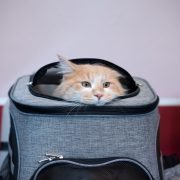Fluorescent tagging for environmental surface cleaning surveillance in a veterinary hospital
Fluorescent tagging for environmental surface cleaning surveillance in a veterinary hospital

Requires membership/payment
This article can be accessed via RCVS Knowledge Library Membership (click here).
In our edition of: Feb 2020
In our categories of: practice management
our summary:
Langdon, G., Hoet, A.E. and Stull, J.W. (2019) Fluorescent tagging for environmental surface cleaning surveillance in a veterinary hospital. Journal of Small Animal Practice, 61 (2), pp. 121-126
The aim of this study was to assess the use of fluorescent tagging for environmental surface cleaning surveillance in a small animal veterinary hospital and identify factors associated with removal of the tag.
The study was carried out in a small animal veterinary teaching hospital where cleaning protocols indicated cleaning and disinfection of clinical surfaces should occur daily. For the study, a range of hospital surfaces were tagged by a single individual using Glo Germ lotion, that was applied to surfaces associated with contamination risks throughout the hospital using cotton-tipped swabs. The tag was placed in locations where it was expected to be removed if the surface was cleaned adequately.
After 24 hours, the same individual used a blacklight to detect the presence of fluorescent tags, to evaluate the effectiveness of surface cleaning. Surfaces were recorded as cleaned if the tag had been completely removed. Whenever possible, the same exact location of surfaces were followed throughout the study. Other than the study team, no other individuals were informed about the study.
Over a period of 5.5 consecutive weeks, 4,984 surfaces were evaluated. Overall, 50% of surfaces were adequately cleaned (complete removal of the tag); and 50% of surfaces were partially or not cleaned.
The study found human-touch surfaces were less likely to be cleaned than animal-touch surfaces.
The most frequently cleaned human-touch surfaces were the equipment cart in the ICU and the door handle to the dog walking area, which were both 100% cleaned. The least frequently cleaned human-touch surfaces were the examination room equipment.
The most frequently cleaned animal-touch surface was the ward cage interior and the least frequently cleaned was the interior of the dog run. The most cleaned area of the hospital was radiology and the least cleaned area was the small animal treatment area.
Limitations to the study include the possibility that staff became aware of the study and therefore changed their typical cleaning behaviour. The study also assumed that removal of the tag was because of purposeful cleaning which may not have been the case.
This study provides some evidence on the effectiveness of fluorescent tagging as a means of monitoring cleaning protocols in the practice environment. Further studies that look at the factors that affect the effectiveness of cleaning with standardised comparisons would be valuable. These would allow targeted strategies to improve environmental cleaning and provide evidence on whether improved cleaning resulted in a reduction of hospital-associated infections.
Image copyright attribute: Alexander Raths
Join the discussion
We encourage discussion on all material highlighted in each edition of inFOCUS. Use the button below to join the conversation on Twitter and include your comment in the feed for this issue.





Leave a Reply
Want to join the discussion?Feel free to contribute!